Investigation of traffic control mechanisms in Data Processing Centers (DPC)
—одержание
- Introduction
- 1. Relevance of the topic
- 2. Purpose and objectives of the study, planned results
- 3. Overview of research and development
- 3.1 Comparative analysis of data center topologies
- 3.2 Analysis of data center traffic management methods
- 3.3 Analysis of general strategies for building an optical network with quality of service parameters
- 4. Analysis of Routing and Spectrum Assignment Approaches in Optical Data Center Networks
- 4.1 Comparative analysis of data center topologies
- 4.2 Analysis of spectrum allocation policies for routing
- Conclusion
- List of Sources
Introduction
The introduction of cloud and data-intensive applications has increased the load on global data centers (datacenters). Consequently, there is a need for high performance with the required quality of service (QoS) parameters. Special transport protocols and traffic management methods, implemented in both hardware and software of data centers, have been developed to provide them. The main components of data center networks, rack switches (ToR, Top of Rack) [1], must be connected via a large interconnect allowing machines to exchange data between racks with servers. Thus, the network described should act as a huge non-blocking switch to which all servers are directly connected, allowing the latter to exchange data simultaneously at maximum speed.
One of the well-known solutions to this problem are EON (Elastic Optic Network) or software-configurable optical networks, for which it is possible to use routing and wavelength assignment (RWA, Routing and wavelength assignment), as well as protection and recovery strategies. Let us consider the proposed solution within the framework of the research task.
1. Relevance of the topic
Modern optical switching technology makes it possible to provide high bandwidths. However, existing limitations, such as dependence on the topology used, the use of micro-electromechanical switches (MEMS), and the use of wavelength-division multiplexing (WDM) mechanism, reduce the efficiency of processing incoming traffic. Thus, the topic of the master's thesis, aimed at research and development of traffic management mechanisms in data centers is relevant.
2. Purpose and objectives of the study, planned results
The aim of the work is to improve the efficiency of elastic optical network resources of data centers with quality of service parameters by developing a method of frequency slot allocation and bandwidth reuse.
To achieve this goal, the following tasks were formulated and solved:
- analysis of the problems of effective of data center traffic management;
- аnalysis of existing mathematical models and methods of optical network spectrum allocation with quality of service parameters;
- development of a mathematical model and method for frequency interval allocation and bandwidth reuse with quality of service provision;
- evaluating the effectiveness of the developed method by simulation modeling and working out recommendations for its practical use.
The object of the study is the process of redistribution of optical resources with quality of service.
Research subject: methods of effective use of available optical network resources.
Research Methods. Methods of routing and spectrum allocation in optical networks were used to develop mathematical models and methods to improve the efficiency of the use of optical network resources. Methods of graph theory, statistical analysis were used to develop a method of spectrum allocation of optical network with quality of service; methods of mathematical modeling, mathematical programming and simulation modeling were used to analyze the proposed mathematical models.
.The following scientific result was obtained while solving the set tasks: the method of increasing the efficiency of network resources utilization was further developed. The novelty of the method consists in improving the method of spectrum allocation of the optical network with the provision of quality of service parameters.
As part of the master's work is planned to obtain the following scientific and practical results:
- The method of increasing the efficiency of the use of network resources has been further developed. The novelty of the method lies in the improvement of The novelty of the method is to improve the method of spectrum allocation of optical network with provision of quality of service parameters;
- It is shown that the proposed strategy of spectrum allocation provides a decrease in the probability of network blocking by 46%, while improving performance by 22%.
3. Overview of research and development
3.1 Comparative analysis of data center topologies
- Ђfull treeї [2]. As shown in Fig. 3.1, the topology is a multirooted tree topology in which each root is called the main switch. It can be viewed as a collapsed Klo network. By increasing the number of roots, it is possible to reduce the over-acceptance ratio (given a fixed channel capacity).
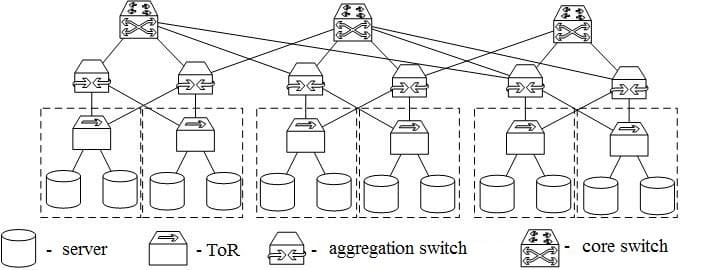
Figure 3.1 — Full tree topology
This topology provides high bandwidth using a large number of less expensive switch, which allows you to support a large number of servers at a much lower cost. The disadvantages of this topology include the use of a complex routing configuration on the switches, to avoid loops when using available paths for load balancing;;
- "leaf-barrel," Fig. 3.2, a two-level topology where the "leaves" (ToR switches) are bound to servers and each backbone switch is directly connected to all "leaf" switches, similar to a bipartite graph.
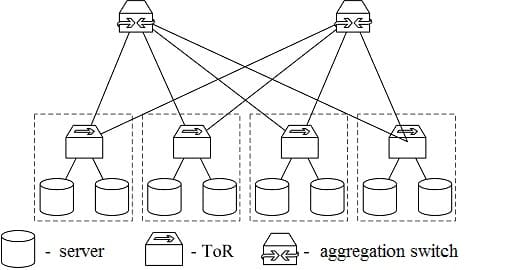
Figure 3.2 — Leaf-barrel topology
The links connected between the servers and the edge switches may have different bandwidth than the links connecting the edge switches to the backbone. The topology simplifies capacity and port expansion (by adding more trunk or leaf switches), and allows direct use of load-balanced routing without creating loops. The disadvantage of the topology is the increased cost of high-capacity trunk switches with more ports as the number of servers in the cluster increases
- virtual level 2 (VL2) [3], presented in Fig. 3.3 is characterized by the fact that it implements all routing and forwarding functions over collapsed Clo networks.
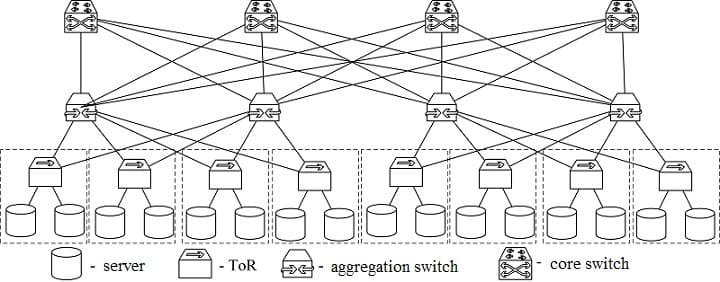
Figure 3.3 — VL2 topology
The difference between this topology and "full tree" is that the bandwidth between the switches is larger than the server-switch lines. This requires fewer physical lines between the aggregation and core layers. to connect the aggregation and core layers. Each ToR switch is connected to two aggregation switches so that each aggregation switch is connected to an equal number of edge switches;
- "jellyfish" [4], presented in Fig. 3.4, a topology in which the ports of the ToR switches are connected randomly until more channels can be added;
then, for any S-switch with two or more free ports, the existing A-B channel is removed and two channels are added between the two free S
and the two ends of the remote network channel (i.e. A-S and B-S) until the switch has more than one port.
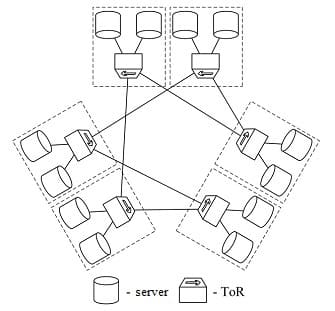
Figure 3.4 — Jellyfish topology
Because ToR switches are directly connected, the average path (number of hops) is much smaller compared to three-layer collapsed Clo networks. The advantages of the topology include its scalability: at full channel load, this topology supports more servers than the "full tree" topology. In addition, with the same number of line failures, the average throughput per server in the "Medusa" topology is higher than in the "full tree" topology. The disadvantages of this topology are the low efficiency of existing routing schemes. For this topology it is assumed to use a joint streaming routing on the shortest paths with multipath TCP (MPTCP) [5].
- D-cluster, shown in Fig. 3.5 is a hierarchical data center topology [6],
in which a higher-level cluster is built by combining several structures of lower-level clusters.
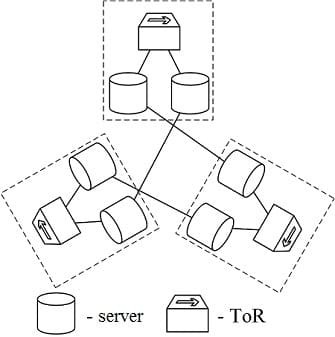
Figure 3.5 — D-cluster topology
The advantages of this topology include the use of a proprietary fault-tolerant routing algorithm. This allows you to achieve a higher level of network throughput compared to conventional tree topologies. On the other hand, implementing such a topology requires changes in the network protocol stack of the server;
- extender topology [7], presented in Fig. 3.6 is based on the extended graphs [8].
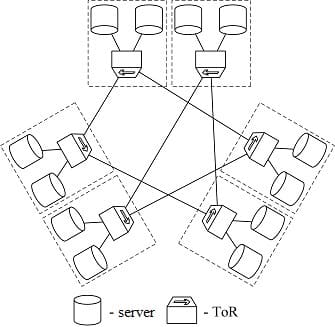
Figure 3.6 — Extender topology
It combines all the performance improvements of the "Medusa" topology over the "full tree" topology with higher throughput as the network gradually expands. This topology is created by connecting multiple meta-nodes based on the following rules: first, each meta-node consists of an equal number of ToR switches; secondly, no two ToR-switches are connected within the same meta-node; thirdly, the same number of lines is used to connect each pair of meta-nodes. The advantages of this topology include its structured nature, which increases the predictability of data center states.
Despite all the above-mentioned advantages of data center topologies, the transition to optical network technologies will allow to provide more bandwidth (Tbit/s in each routable fiber) regardless of the distance. Also, optical switching can be more flexible and, thanks to multi-wavelength routing, it allows not only to improve existing data center topologies, but also to increase service quality parameters.
Transparent optical networks are connection-oriented networks that can be configured during network operation to best accommodate the volatile traffic of data centers. Compared to electrical switches, optical switches dissipate less heat, resulting in lower cooling costs. In addition, optical switching can seamlessly increase throughput to 100 Gbps and beyond to meet the growing demand for storage.
3.2 Analysis of data center traffic management methods
At the moment there is a fairly large number of works aimed at describing various methods of traffic management, pursuing one or another goal, Figure 3.7.
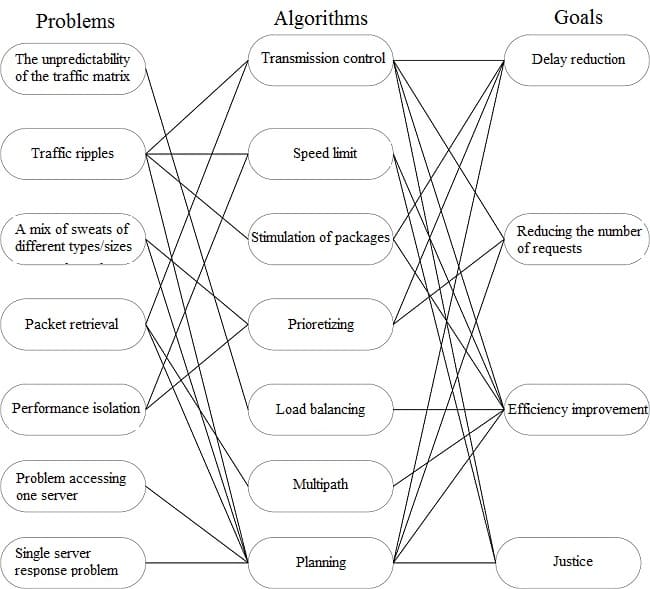
Figure 3.7 — Correlation of traffic management problems with algorithms to reduce them and goals to be achieved
It is clear from the interaction shown in the figure that depending on the problem posed and the goal pursued, for example, ensuring the quality of service parameters, It is also worth noting that depending on the architecture of optical networks used, it is worth investigating not only the issues of quality of service parameters, but also the issues of survivability.
3.3 Analysis of common strategies for building an optical network with quality of service parameters
For conventional optical networks, survivability is an important parameter. Fast recovery, due to sub-channel protection, for WDM networks is explained in [9]. The principle of this procedure, the following: a large optical network is divided into a smaller domain and the proposed protection of the subchannel, as well as the protection of the common channel.
Survivability in the event of an optical network failure is described in [10]. Obviously, in the situation presented, which arises from natural disasters, a varied approach is necessary.
In the work[11] the scheme of intermediate and preliminary redundancy in elastic optical networks was studied. In [12-13] quality of Service (QoS) protection schemes for flexible optical networks are proposed. In [14] the routing mechanism and assignment of spectrum in elastic optical networks.
Channel and link fault protection/recovery schemes (line and node) in WDM optical networks are presented in [15]. Line and node failure in optical networks leads to simultaneous failure of several optical channels, resulting in a huge loss of data and revenue for the network operator. Wavelength bandwidth requirements for primary and backup route and routing assignments are discussed in [16]. The proposed survivability approach for multiple network failures is also described here, and the switching recovery time and recovery time are explained.
A strategy for restoring shared bandwidth in elastic optical networks is proposed in [17]. In [18] the key features of the survivability of optical networks are analyzed. Network recovery is defined as a network that provides uninterrupted services even after a network failure has occurred. The bandwidth of a fiber-optic network is specified in Gbps and Tbps.
Work [19] deals with the quasi-channel reconstruction scheme, presents the definition of basic network parameters of different topologies (COST239, NSFNET and ARPANET), bandwidth provisioning and resource utilization coefficients.
4 Analysis of Routing and Spectrum Assignment Approaches in Optical Data Center Networks
4.1 Analysis of Routing Approaches in Elastic Optical Data Center Networks
The problem of routing and spectrum assignment in elastic optical networks can be divided into two areas: online and offline RSA. For offline operation, successful RSA requires knowledge of the topology and traffic service requirements in advance. For online operation, the network topology is known in advance, and the traffic service requirements come at random.
For fixed routing, the routes of each source-receiver pair are predefined. When a connection request is received, the algorithms establish a light channel along a predefined route. In minimum-over-routing, the weight of each connection is set to 1, and a route corresponding to the minimum route is selected. In shortest path routing, the physical length of the link is used as the weight, and the path is chosen using shortest path finding algorithms such as Dijkstra's algorithm.
daptive routing algorithms dynamically select routes depending on the state of the network. In this case, unused channels in the network are assigned a single cost, and when a connection request is received, the route with the lowest cost is dynamically selected. To route the least-used path, the connection is determined by the number of free frequency slots available in the channel, and the channel with the maximum available free wavelengths is selected to establish the connection. A power series routing algorithm based on bi-components for adaptive routing, where it can be optimized and adapted to network conditions. In the planning phase, a channel cost function such as normalized channel availability and normalized channel length are used to determine the input variable.
The authors in [20] proposed to formulate a nonlinear programming problem based on channel state for autonomous RSA as a flow problem with multiple goods, considering the constraints of protective carrier in addition to the constraints of spectrum continuity and subcarrier sequence when allocating them according to traffic needs. A solution for the DLC formulation is obtained to minimize the maximum number of subcarriers allocated on any fiber, the maximum subcarrier index allocated on any fiber, and the total number of subcarriers over all fibers. In this work, the authors also calculated the upper and lower bounds of the optimal solution for ring and mesh networks with specified and unspecified routing.
In [21] the authors proposed, close to the channel state, a formulation of the RSA problem known as the routing, wavelength assignment, and spectrum allocation problem. In [22] the authors proposed a routing algorithm that computes several alternative paths for each connection request. The spectrum allocation algorithm is then used to determine the set of available contiguous slots that are assigned to the request. Authors [23] proposed an adaptive routing algorithm to solve the first subtask of the routing tables at each node and associate a probability with each pair. Then the ant colony optimization algorithm is executed continuously, which updates these probabilities based on spectrum usage, and the optimal path is determined. Once the path is chosen, the first fit policy is used to distribute the spectrum.
The authors in [24-25] used an integer programming problem with a spectrum assignment strategy first fit and found an optimal solution to the RSA/RMSA problem using pre-calculated - shortest paths for routing. The simulation result shows that the proposed heuristic reduces the probability of network blocking to 9.4% with a run time of less than one second.
In [27] the authors considered a dynamic version of the RMSA problem, decomposing it into subproblems of dynamic routing rate selection and channel selection. The authors additionally used graph theory to solve the dynamic routing and channel selection problems. In [28] presented two different one-step online RSA algorithms. The first algorithm used a modified Dijkstra shortest-path search algorithm that used channels with enough subcarriers in ascending order of path length. The second one-step RSA algorithm constructs a path vector at the source node such that all channels of each path have sufficient continuous spectrum. The algorithm then searches the path vectors to find the channel with sufficient available spectrum and minimal cost.
The authors in [29] we presented an integer programming model of the static RSA problem in EON in order to minimize the number of subcarriers in EON. The authors also analyzed upper and lower bounds on the maximum number of subcarriers in conventional and ring networks. Two heuristic algorithms balanced spectrum allocation and shortest path with maximum spectrum reuse are proposed to solve the RSA problem in a large network. The simulation result confirms the solution of the integer programming model and heuristic algorithms with optimal resource utilization.
In [30] the authors presented a mixed line rate (MLR) architecture for serving heterogeneous traffic. The authors have developed a mathematical case model for the design of energy efficient and cost effective MLR optical networks. Evaluation of the performance of the developed model under different traffic load scenarios shows that MLR networks can improve the energy efficiency of the network architecture.
The authors in [31] proposed a distance-adaptive routing, spectrum assignment, and reconfiguration algorithm to solve the problem of time-defined request provisioning (DDR) in EOS networks. DDR provisioning requires that data be transmitted within a given time frame without imposing specific bandwidth requirements. Simulation results show significant performance improvements due to bandwidth redistribution. The authors in [32] presented the RSA problem using channels as a set of adjacent subcarriers of a given width to model the spectrum continuity constraint. For a given width of spectrum, all possible channels with subcarriers are defined on each link of the network. The RSA problem is then transformed into a continuous spectrum channel routing and distribution problem. This mechanism leads to a more compact formulation of the integer programming problem, which provides a significant reduction in running time compared to direct spectrum continuity constraints..
The authors[33-34] proposed two RSA algorithms based on -shortest path algorithms using FF to assign spectrum in a dynamic scenario. In [35] the authors presented a three-stage dynamic routing scheme taking into account quality of transmission (QoT), modulation level and spectrum assignment (QoT-aware RSA). Two modified algorithms are used to calculate the path: Dijkstra and the traffic balancing algorithm for spectrum assignment. Simulation results show that the proposed algorithm works efficiently and provides a higher signal-to-noise ratio of the optical signal compared to the FF, RF and SA strategies.
Authors [36-37] used multipath routing, splitting the incoming traffic request into several requests and using several paths for their transmission. Simulation analysis shows that the proposed schemes work more efficiently than single-path routing.
Further research on routing algorithms has shown that additional mechanisms, such as spectrum fragmentation, need to be applied.
4.2 Analysis of spectrum allocation policies for routing
The BLSA algorithm, to reduce the maximum number of subcarriers in the fiber, is based on load balancing. First, the algorithm generates k shortest paths for each source-receiver pair. Then, based on the estimation of the fiber load, the channel is selected. The decision algorithm is simple: the channel whose maximum load is minimal is selected. Spectrum allocation is then performed using assignment strategies: First Fit (FF), Exact Fit (EF) or Random Fit (RF).
The fiber loading can be determined according to formula (4.1):
Sl –number of occupied slots for the network section in question; Subg –number of protective carriers; Och –number of channels in the fiber.
Fragmentation Aware Routing (FA) is used as a basic routing algorithm to increase the efficiency of spectrum resource utilization. Fragmentation is not directly related to spectrum usage, but it can be used as a decisive parameter for routing. The process of adding and terminating connections in an uneven bandwidth assignment generates alternating spectrum. Obviously, spectrum fragmentation becomes a problem when free resources are split into portions smaller than the incoming bandwidth requests. Consequently, these small non-contiguous free frequencies reduce spectrum efficiency, which is achieved at the expense of flexibility in bandwidth allocation.
In the advanced FA, the notion of external fragmentation estimation is used to select one of the possible -paths for each incoming source-receiver connection request. Thus, the path is selected based on the fragmentation score of each desired fiber. From the Maximum Fiber Fragmentation (MFF) estimates of each path, the channel with the lowest MFF is selected. Once the channel is selected, spectrum allocation is performed using one of the previously listed strategies. In a concurrent request situation, higher priority traffic requires more allocation than lower priority traffic.
An estimate of the external fiber fragmentation can be calculated using formula (4.2):

Lfb –the largest free block (LFB), i.e. the number of slots of the largest continuous free space; Slf –the total number of free slots.
In EON, for incoming connection requests, spectrum slots are allocated in varying degrees of granularity. The FF policy serves the request in the first available bandwidth corresponding to the required spectrum. The RF policy places incoming requests in any available block large enough to satisfy the required bandwidth. The EF policy looks for the exact available block in terms of the number of slots requested for the connection. If a perfectly matched block is not available, spectrum is allocated in the first available free block.
To investigate the combination of different RSA and fragmentation schemes, a simulation was performed using the known COST 239 topology in truncated form (6 nodes) and for the 7-node optical structure presented in Figure 1 (a) and 1 (b), respectively.
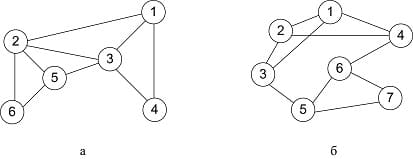
Figure 4.1 — Topologies used for simulation: COST 239 in truncated form (a) and 7-node optical structure (b)
The simulation was reduced to several stages. At the first stage, the routing methods described earlier (SPSR, BLSA, FA) were investigated. As an assessment of the quality of performance of the simulation models, a score called Incoming Requests Load (IRL) was used. This number characterizes the average value obtained as the product of the average service time, average arrival rate and the number of requests per connection.
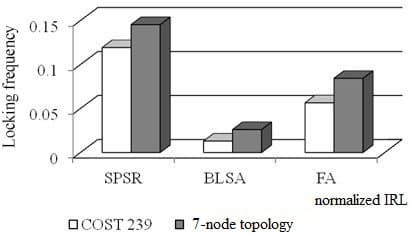
Figure 4.2 — Comparison of blocking frequency values for SPSR, BLSA and FA
The chart in Figure 4.2 shows the average values of the 60 realized simulations.
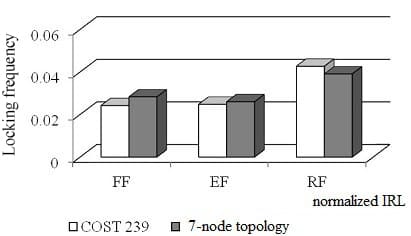
Figure 4.3 — Comparison of blocking frequency values for different fragmentation policies for the BLSA routing algorithm
From the presented diagram we can see that the FA and BLSA routing algorithms showed better results than SPSR, regardless of the topology of the optical network. Let us consider the fragmentation policies for the above algorithms. To do this, we conduct the appropriate simulation and present the results in the form of appropriate diagrams, Figures 4.3 and 4.4.
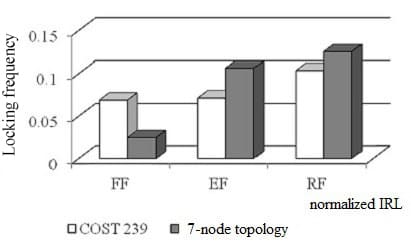
Figure 4.4 — Comparison of blocking frequency values for different fragmentation policies for the FA routing algorithm
In terms of using fragmentation policies, EF remains the most universal way.
Since the nonlinearity effects of the physical layer were not taken into account when modeling the deployed network, the BLSA and FA methods significantly outperformed shortest path routing. Only the notion of external fragmentation was investigated in the developed algorithms.
The differences between the First-Fit and Exact-Fit policies are insignificant for BLSA and FA. In general, the Exact-Fit spectrum allocation policy performed slightly better than First-Fit. However, since this did not happen in all cases, a much larger number of simulations in other topologies are needed to draw a convincing conclusion on this issue.
Conclusions
In the process of performing the master's thesis on "Research on traffic management mechanisms in data centers (DPCs)" its relevance is presented. The purpose and tasks to be performed to achieve the goal are formulated.
Master's thesis is devoted to the actual scientific problem of increasing the efficiency of elastic optical network resources of data centers with the provision of quality of service parameters by developing a method of frequency interval allocation and bandwidth reuse.
As part of the research carried out:
- an analysis of data center network traffic management problems has been carried out;
- mathematical models of the optical network spectrum allocation strategy were developed and based on them the method of optical network spectrum allocation with service quality assurance was developed.
Further research is aimed at the following: to evaluate the effectiveness of the developed method by simulation modeling and development of recommendations for its practical use.
At the time of writing this abstract, the master's work is not yet complete. Final completion: May 2023. The full text of the work and materials on the topic can be obtained from the author or his supervisor after that date.
References
- Ban, M.F. Data center network visualization: A survey / M.F. Ban and others// IEEE Communications Surveys and Tutorials, 2013. Ц Vol. 15. Ц Pp. 909-928
- Habib, M.F. Fault-tolerant virtual network mapping to provide content connectivity in optical networks / M.F. Habib, M. Tornatore, B. Mukherjee // Optical Fiber Communication Conference and Exposition and the National Fiber Optic Engineers Conference (OFC/NFOEC), 2013. Ц Pp. 1-3.
- Al-Fares, M. A Scalable, Commodity Data Center Network Architecture/ M. Al-Fares, A. Loukissas, A. Vahdat // Proceedings of the ACM SIGCOMM 2008 Conference on Data Communication, 2008. Ц Pp. 63Ц74.
- Greenberg, A. VL2: A Scalable and Flexible Data Center Network / A. Greenberg and others // Commun. ACM, 2011. Ц Vol. 54, no. 3. Ц Pp. 95Ц104.
- Naas, N. On determining the cost-effective optical transport network architecture for next generation data center interconnectivity/ N. Naas, H. Mouftah // IEEE Canadian Conference on Electrical and Computer Engineering (CCECE), Vancouver, 2016. Ц Pp. 1-6.
- Guo., B. Survivable virtual network design and embedding to survive a facility node failure/ B. Guo and others // Journal of Lightwave Technology, 2014. Ц Vol. 32. Ц Pp. 483-493.
- Wright, P. The network capacity benefits of flexgrid/ P. Wright, A. Lord, L. Velasco // 17th International Conference on Optical Networking Design and Modeling (ONDM). 2013. Ц Pp. 7- 12
- Gong, L. Virtual optical network embedding (VONE) over elastic optical networks / L. Gong, Z. Zhu// Journal of Lightwave Technology, 2014. Ц Vol. 32, no. 3. Ц Pp. 450-460.
- Zhang, X. Survivable green IP over WDM networks against double-link failures/ X. Zhang, H. Wang, Z. Zhang// Computer Networks, 2014. Ц Vol. 59. Ц Pp. 62-76.
- Ramamurthy, S. Survivable WDM mesh networks / S. Ramamurthy, L. Sahasrabuddhe, B. Mukherjee // Light. Technol. J., 2003. Ц Vol. 21, no. 4. Ц pp. 870Ц883.
- ÷уканов, ¬. Ќ. ¬олоконно-оптическа€ техника: практическое руководство / ¬. Ќ. ÷уканов, ћ. я. яковлев. Ц 4-е изд. Ц ћосква, ¬ологда: »нфра-»нженери€, 2019. Ц 300 c. Ц ISBN 978-5-9729-0367-2. Ц “екст: электронный // ÷ифровой образовательный ресурс IPR SMART : [сайт]. Ч URL: https://www.iprbookshop.ru/86560.html.
- Zhang, G. A Survey on OFDM Based Elastic Core Optical Networking / G. Zhang and others // IEEE Commun. Surveys & Tutorials, 2013. Ц Pp.65Ц87.
- Bocoi, A. Reach-dependent capacity in optical networks enabled by OFDM/ A. Bocoi and others // Optical Fiber Communication Conference and Exposition (OFC/NFOEC), 2009.
- Casellas, R. Design and Experimental Validation of A GMPLS/PCE Control Plane for Elastic CO-OFDM Optical Networks/ R. Casellas // IEEE JSAC, 2013. Ц Vol. 31. Ц Pp. 49-61.
- Wan, X. Dynamic routing and spectrum assignment in flexible optical path networks / X. Wan and others // Proceedings of OFC/NFOEC, 2011. Ц Pp. 1-3.
- Rosa, A. Spectrum allocation policy modeling for elastic optical networks/ A. Rosa and others // High Capacity Optical Networks and Emerging/Enabling Technologies, Istanbul, 2012. Ц Pp. 242-246.
- Fei, Yue Handling race conditions among bidirectional LSP requests via WA-method-TLV in GMPLS WDM networks/ Yue Fei // 19th European Conference on Networks and Optical Communications Ц (NOC), 2014. Ц Pp. 185-190.
- Wang, Y. A study of the routing and spectrum allocation in spectrum-sliced elastic optical path networks/ Y. Wang, X. Cao, Y. Pan// Proceedings of IEEE INFOCOM, 2011. Ц Pp. 1503Ц1510.
- Yang, W. Towards Elastic and Fine-Granular Bandwidth Allocation in Spectrum-Sliced Optical Networks / W. Yang and others // J. OPT. COMMUN. NETW., 2012. Ц Vol. 4, no. 11.
- Victor, L. Elastic Optical Networks: Architectures, Technologies, and Control/ L. Victor, V. Luis// Springer International Publishing, 2016.
- Gringeri, S. Flexible architectures for optical transport nodes and networks/ S. Gringeri// IEEE Communications Magazine, 2010. Ц Vol. 48, no. 7. Ц Pp. 40-50.
- Patel, A.N. Routing, wavelength assignment, and spectrum allocation in transparent flexible optical WDM (FWDM) networks / A.N. Patel and others // Integrated Photonics Research, Silicon and Nanophotonics and Photonics in Switching. Optical Society of America, 2010.
- Gerstel, O. Flexible Use of Spectrum and Photonic Grooming/ O. Gerstel// Proceedings of Photonics in Switching (IPR/PS), Monterey (USA), 2010.
- Christodoulopoulos, K. Routing and spectrum allocation in OFDM-based optical networks with elastic bandwidth allocation/ K. Christodoulopoulos, I. Tomkos, E.A. Varvarigos // IEEE Global Telecommunications Conf., 2010
- Sone, Y. Routing and spectrum assignment algorithm maximizes spectrum utilization in optical networks/ Y. Sone // European Conf. and Exhibition on Optical Communication, 2011.
- Wang, Y. Routing and spectrum assignment by means of ant colony optimization in flexible bandwidth networks/ Y. Wang and others// OFC/NFOEC, 2012. Ц Pp. 1-3
- Klinkowski, M. Routing and Spectrum Assignment in Spectrum Sliced Elastic Optical Path Network/ M. Klinkowski, K. Walkowiak// IEEE Communications Letters, 2011. Ц Vol. 15, no. 8. Ц pp. 884-886.
- Patel, A.N. Dynamic routing, wavelength assignment,and spectrum allocation in transparent flexible optical WDM networks/ A.N. Patel and others// Optical Metro Networks and Short-Haul Systems ill, 2011.
- Wan, X. Dynamic routing and spectrum assignment in flexible optical path networks/ X. Wan and others// Proceedings of OFC/NFOEC, 2011. Ц Pp. 1-3.
- Wang, Y. Routing and Spectrum Allocation in Spectrum-Sliced Elastic Optical Path Networks: A Primal-Dual Framework [Ёлектронный ресурс]/ Y. Wang and others // Electronics, 2021/ –ежим доступа: https://doi.org/10.3390/electronics10222809.
- Chowdhury, P. On the Design of Energy-Efficient Mixed-Line-Rate (MLR) Optical Networks/ P. Chowdhury // Journal of Lightwave Technology, 2012. Ц Vol. 30, no. 1. Ц Pp. 130-139.
- Morell, J. Distance-adaptive routing and spectrum assignment of Deadline Driven Requests in Reconfigurable Elastic Optical Networks/ J. Morell, G. Sahin// ICSNC 2012: The Seventh International Conference on Systems and Networks Communications 2012, 2012.
- Afsharlar, Pegah Routing and Spectrum Assignment With Delayed Allocation in Elastic Optical Networks/ Pegah Afsharlar// J. Opt. Commun. Netw. 9, 2017. Ц Pp. 101-111.
- Casellas, R. Design and experimental validation of a GMPLS/PCE control plane for elastic CO-OFDM optical networks/ R. Casellas // IEEE J. Se!. Areas Commun., 2013. Ц Vol. 31, no. 1. Ц Pp. 49-61.
- Le, Hai-Chau Spectrum Utilization Efficiency of Elastic Optical Networks Utilizing Coarse Granular Routing [Ёлектронный ресурс]/ Hai-Chau Le, Ngoc Dang // Informatica. –ежим доступа:https://www.researchgate.net/publication/328593618.
- Beyranvand, H. A Quality-of-Transmission Aware Dynamic Routing and Spectrum Assignment Scheme for Future Elastic Optical Networks/ H. Beyranvand, J. A. Salehi// Journal of Lightwave Technology, 2013.Ц Vol. 31, no. 18. Ц Pp. 3043-3054.
- Zhu, Z. Dynamic service provisioning in elastic optical networks with hybrid single-multi-path routing/ Z. Zhu, W. Lu, L. Zhang, N. Ansari// J. Lightwave Technol. Ц Vol. 31, no. 1 Ц Pp. 15-22.
